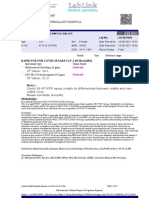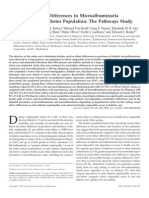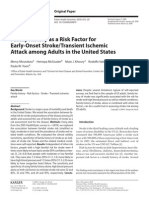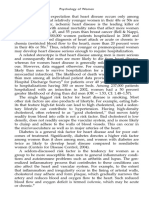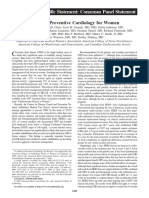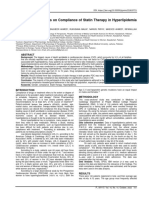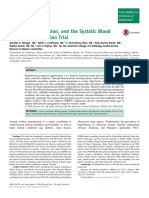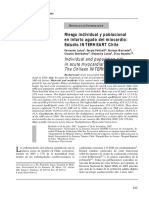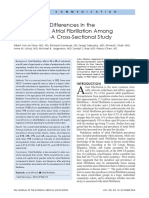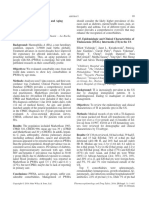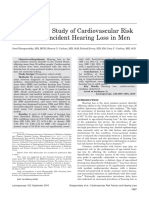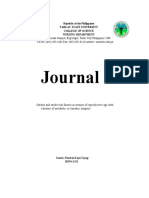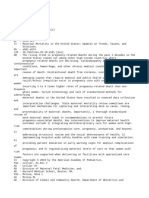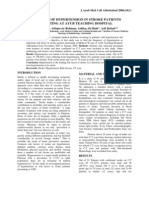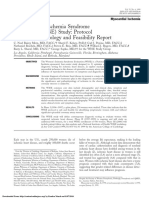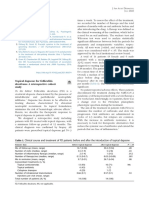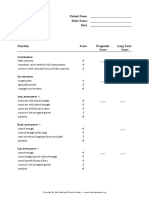0 ratings0% found this document useful (0 votes)
34 viewsNi Hms 366201
Ni Hms 366201
Uploaded by
Habiburrahman EffendyThis document summarizes a study that examined the association between early menopause (before age 46) and future risk of coronary heart disease (CHD) and stroke. The study used data from the Multi-Ethnic Study of Atherosclerosis (MESA), which included over 2,500 women of various ethnicities in the US. The results showed that 28% of women reported early menopause. Women with early menopause had worse survival rates free from CHD and stroke. Even after adjusting for traditional risk factors, early menopause predicted higher risks of future CHD (hazard ratio 2.08) and stroke (hazard ratio 2.19). Therefore, the study concludes that early menopause independently
Copyright:
© All Rights Reserved
Available Formats
Download as PDF, TXT or read online from Scribd
Ni Hms 366201
Ni Hms 366201
Uploaded by
Habiburrahman Effendy0 ratings0% found this document useful (0 votes)
34 views17 pagesThis document summarizes a study that examined the association between early menopause (before age 46) and future risk of coronary heart disease (CHD) and stroke. The study used data from the Multi-Ethnic Study of Atherosclerosis (MESA), which included over 2,500 women of various ethnicities in the US. The results showed that 28% of women reported early menopause. Women with early menopause had worse survival rates free from CHD and stroke. Even after adjusting for traditional risk factors, early menopause predicted higher risks of future CHD (hazard ratio 2.08) and stroke (hazard ratio 2.19). Therefore, the study concludes that early menopause independently
Original Description:
contoh
Copyright
© © All Rights Reserved
Available Formats
PDF, TXT or read online from Scribd
Share this document
Did you find this document useful?
Is this content inappropriate?
This document summarizes a study that examined the association between early menopause (before age 46) and future risk of coronary heart disease (CHD) and stroke. The study used data from the Multi-Ethnic Study of Atherosclerosis (MESA), which included over 2,500 women of various ethnicities in the US. The results showed that 28% of women reported early menopause. Women with early menopause had worse survival rates free from CHD and stroke. Even after adjusting for traditional risk factors, early menopause predicted higher risks of future CHD (hazard ratio 2.08) and stroke (hazard ratio 2.19). Therefore, the study concludes that early menopause independently
Copyright:
© All Rights Reserved
Available Formats
Download as PDF, TXT or read online from Scribd
Download as pdf or txt
0 ratings0% found this document useful (0 votes)
34 views17 pagesNi Hms 366201
Ni Hms 366201
Uploaded by
Habiburrahman EffendyThis document summarizes a study that examined the association between early menopause (before age 46) and future risk of coronary heart disease (CHD) and stroke. The study used data from the Multi-Ethnic Study of Atherosclerosis (MESA), which included over 2,500 women of various ethnicities in the US. The results showed that 28% of women reported early menopause. Women with early menopause had worse survival rates free from CHD and stroke. Even after adjusting for traditional risk factors, early menopause predicted higher risks of future CHD (hazard ratio 2.08) and stroke (hazard ratio 2.19). Therefore, the study concludes that early menopause independently
Copyright:
© All Rights Reserved
Available Formats
Download as PDF, TXT or read online from Scribd
Download as pdf or txt
You are on page 1of 17
Early Menopause Predicts Future Coronary Heart Disease and
Stroke: The Multi-Ethnic Study of Atherosclerosis (MESA)
Melissa Wellons, MD, MHS, NCMP
1
, Pamela Ouyang, MBBS
2
, Pamela J Schreiner, PhD
3
,
David M Herrington, MD
4
, and Dhananjay Vaidya, MBBS, PhD
2
1
University of Alabama, Birmingham, AL
2
J ohns Hopkins Medical Institute, Baltimore, MD
3
University of Minnesota, Minneapolis, MN
4
Wake Forest University, Winston-Salem, NC
Abstract
ObjectiveCardiovascular disease is the number one killer of women. Identifying women at risk
of cardiovascular disease has tremendous public health importance. Early menopause is associated
with increased cardiovascular disease events in some predominantly white populations, but not
consistently. Our objective was to determine if a self-reported early menopause (menopause at an
age <46) identifies women as at risk for future coronary heart disease or stroke.
MethodsThe study population came from the Multi-Ethnic Study of Atherosclerosis, a
longitudinal, ethnically diverse cohort study of US men and women aged 45 to 84 years enrolled
in 20002002 and followed up until 2008. The association between a personal history of early
menopause (either natural menopause or surgical removal of ovaries at an age <46) and future
coronary heart disease and stroke was assessed in 2509 women (ages 4584, 987 White, 331
Chinese, 641 Black, 550 Hispanic) from the Multi-Ethnic Study Atherosclerosis, who were free of
cardiovascular disease at baseline.
Results693/2509 (28%) of women reported either surgical or natural early menopause. In
survival curves, women with early menopause had worse coronary heart disease and stroke-free
survival (log rank p=<0.008 and 0.0158). In models adjusted for age, race/ethnicity, Multi-Ethnic
Study Atherosclerosis site and traditional cardiovascular disease risk factors, this risk for coronary
heart disease and stroke remained (HR 2.08, 95% CI 1.17, 3.70 and 2.19, 95% CI 1.11, 4.32,
respectively).
ConclusionsEarly menopause is positively associated with coronary heart disease and stroke
in a multiethnic cohort, independent of traditional cardiovascular disease risk factors.
Keywords
Early Menopause; Coronary Heart Disease; Stroke
Corresponding Author: Melissa Wellons, MD, MHS, NCMP, Division of Reproductive Endocrinology and Infertility, University of
Alabama at Birmingham, 1700 6th Avenue South, WIC Room 10390, Birmingham, AL 35249-7333, Telephone: (205) 934-1030 Fax:
(205) 975-5732, mwellons@uab.edu.
Publisher's Disclaimer: This is a PDF file of an unedited manuscript that has been accepted for publication. As a service to our
customers we are providing this early version of the manuscript. The manuscript will undergo copyediting, typesetting, and review of
the resulting proof before it is published in its final citable form. Please note that during the production process errors may be
discovered which could affect the content, and all legal disclaimers that apply to the journal pertain.
Financial disclosures/conflicts of interest: None reported.
NIH Public Access
Author Manuscript
Menopause. Author manuscript; available in PMC 2013 October 01.
Published in final edited form as:
Menopause. 2012 October ; 19(10): 10811087. doi:10.1097/gme.0b013e3182517bd0.
N
I
H
-
P
A
A
u
t
h
o
r
M
a
n
u
s
c
r
i
p
t
N
I
H
-
P
A
A
u
t
h
o
r
M
a
n
u
s
c
r
i
p
t
N
I
H
-
P
A
A
u
t
h
o
r
M
a
n
u
s
c
r
i
p
t
INTRODUCTION
Cardiovascular disease (CVD) is the leading cause of death in US women.
1
The early
identification of women at high risk of CVD and implementation of appropriate lifestyle and
medical therapy is of tremendous public health importance. Current strategies for identifying
high risk women involve counting major coronary heart disease (CHD) factors and
estimating 10-year risk with algorithms.
24
The algorithm most commonly used to identify
women at high risk of CHD, the Framingham risk score, relies heavily on age and
biomarkers. Clinical history including smoking history is incorporated. However,
reproductive health history is not, yet a number of cohort studies have identified an
association between early menopause and cardiovascular risk.
512
The second Adult Treatment Panel (ATP II) report included a history of premature
menopause in global CVD risk assessment.
13
It considered premature menopause without
estrogen therapy a risk factor for CHD. This plus one other risk factor (family history of
premature CHD, current cigarette smoking, hypertension, low high-density lipoprotein
(HDL) HDL cholesterol, or diabetes) identified a woman as having high CHD risk. This was
based on observational studies that indicated that increases in LDL with menopause were
reversed by hormone therapy (HT).
14
The panel posited that the presence of estrogen may
protect women from CHD. However, subsequent panels (ATP III
3, 15
) dropped early
menopause as a risk factor. This may have been because HT was not shown to confer
protection from CHD in randomized trials.
16,17
Whether HT benefits vascular health is intensely debated. However, observational studies
consistently show that early age at menopause is associated with CHD
7,10
and possibly
stroke.
9
These studies have included mostly white or European populations and may not be
generalizable to US women not of European origin. Therefore, we investigated whether
early menopause (menopause before age 46 yrs) was associated with CHD and stroke in a
multi-ethnic population of US women. We further investigated whether this relationship was
independent of traditional CVD risk factors.
METHODS
Design Overview, Setting, and Participants
Multi-Ethnic Study Atherosclerosis (MESA) is a multi-center, longitudinal cohort study of
the prevalence and correlates of subclinical CVD and the factors that influence its
progression.
18
Between July 2000 and August 2002, 3213 men and 3601 women who
identified themselves as white, black, Hispanic, or Chinese, reported that they were free of
CVD, and were 45 to 84 years of age, were recruited from 6 US communities: Baltimore
City and Baltimore County, Maryland; Chicago, Illinois; Forsyth County, North Carolina;
Los Angeles County, California; Northern Manhattan and the Bronx, New York; and St.
Paul Minnesota. Details on the sampling frames and the cohort examination procedures have
been published previously.
18
Informed consent was obtained from each participant and the
study was approved by the Institutional Review Boards of each institution.
At the baseline exam (July 2000 to August 2002), medical history, anthropometric
measurements, and laboratory data were obtained. Age, gender, ethnicity, and medical and
medication histories were obtained by questionnaire. Family history of CVD was defined as
having a self-reported history of a first-degree relative (parent, sibling, or child) with heart
attack. Ever smoking was defined as having smoked 100 cigarettes in a lifetime. Diabetes
mellitus was defined as a fasting glucose 126 mg/dL
19
or use of a hypoglycemic
medication.
Wellons et al. Page 2
Menopause. Author manuscript; available in PMC 2013 October 01.
N
I
H
-
P
A
A
u
t
h
o
r
M
a
n
u
s
c
r
i
p
t
N
I
H
-
P
A
A
u
t
h
o
r
M
a
n
u
s
c
r
i
p
t
N
I
H
-
P
A
A
u
t
h
o
r
M
a
n
u
s
c
r
i
p
t
Blood pressure, weight and height were measured using standardized protocols.
18, 20
Hypertension was defined as a systolic blood pressure (BP) >140 mm Hg, diastolic BP >90
mm Hg (JNC VI
21
), or self report of hypertension plus the use of an antihypertensive
medication. Body mass index (BMI) was calculated as the weight (kg) height squared
(m2). Plasma total and HDL cholesterol and glucose were measured after a 12-hour fast.
As part of the in-person MESA baseline assessment questions relevant to menopausal status
were asked of women participants. Natural menopause was determined with the questions:
Have you gone through menopause (change of life)? or Are you currently going through
menopause? Age at natural menopause was determined with the question At what age did
you go through menopause (year)? Surgical menopause was determined with the question
Have you had surgery to remove your ovaries? Age at surgical menopause was
determined with the question At what age? All women were asked Have you ever taken
hormone replacement therapy?
These questions were asked as part of an interviewer-administered form. For each question,
possible responses are Yes, No, Dont Know, and/or Not Applicable or N/A (not
applicable). The interviewer was instructed to have the participant choose the appropriate
responses for each question. The interviewers were instructed not to probe or to make
interpretations about a participants specific symptoms. They were instructed to ask
questions as written and record answers as given. Chart reviews were not performed to
confirm menopausal status or surgical history.
For our study, early menopause was defined as a self-reported menopause at age <46. The
use of the age cutpoint of 46 allowed for the categorization of any woman not reporting
menopause at baseline as unexposed to early menopause. This was because all MESA
women were at least age 45 at enrollment.
Among all MESA women (n=3601), 1261/3601 (35%) reported hysterectomy. This
prevalence of hysterectomy appears consistent with a previously published report from the
National Womens Health Information Center that 1/3 of women age 60 in the US have
undergone hysterectomy.
22
In our study, participants with hysterectomy without
oophorectomy, missing data, or inconsistent data regarding menopausal status were
excluded from our sample (Figure 1). In our sample, 27% of women reported an early
menopause (either natural or surgical). In comparison, in a cohort study of age at natural
menopause and mortality by Snowden et al, age 46 represented the 25
th
percentile for age at
natural menopause.
12
CHD and Stroke Outcomes
The MESA cohort has been followed for incident cardiovascular events for a median of 57.3
months (range of 1.3 to 73.2 months). The primary means of identifying possible events in
MESA is participant self-report via post-baseline contacts (follow-up calls) conducted by
telephone. Field center staff may also learn of potential events in other ways: participants
may notify the clinic when they experience an event; a MESA examination may identify a
possible event; investigation of one event may identify another event; National Death Index
search could identify a death; or field center staff may learn of a participants death through
an obituary or other public notice.
At intervals of 9 to 12 months, a telephone interviewer contacted each participant regarding
hospital admissions, cardiovascular outpatient diagnoses, and deaths. To verify self-reported
diagnoses, copies of all death certificates and medical records for hospitalizations and
outpatient cardiovascular diagnoses were requested. For out-of-hospital cardiovascular
deaths, next-of-kin interviews were performed. Records on an estimated 98% of reported
Wellons et al. Page 3
Menopause. Author manuscript; available in PMC 2013 October 01.
N
I
H
-
P
A
A
u
t
h
o
r
M
a
n
u
s
c
r
i
p
t
N
I
H
-
P
A
A
u
t
h
o
r
M
a
n
u
s
c
r
i
p
t
N
I
H
-
P
A
A
u
t
h
o
r
M
a
n
u
s
c
r
i
p
t
hospitalized cardiovascular events and some information on 95% of reported outpatient
diagnostic encounters were obtained. Two physicians independently reviewed and classified
CVD events and assigned incidence dates. If they disagreed, they adjudicated their
differences via discussion.
Periodically, the Coordinating Center will search the National Death Index for participants
with whom the study has lost touch. The Field Centers will then be notified of these deaths
so that additional information can be obtained and so that the death can go to physician
review. Criteria for events are available on the MESA website (http://www.mesa-nhlbi.org/
Mesa-Internal/manuals.asp) and are described in published MESA manuscripts.
23
Reviewers classified a myocardial infarction (MI) as definite or probable if either abnormal
cardiac biomarkers (two times upper limits of normal) regardless of pain or ECG findings;
evolving Q waves regardless of pain or biomarker findings; or a combination of chest pain,
and ST-T evolution or new LBBB, and biomarker levels 12 times upper limits of normal
was present. Reviewers classified a resuscitated cardiac arrest as present when a subject had
successfully recovered from a full cardiac arrest through cardiopulmonary resuscitation
(including cardioversion). The reviewers classified CHD death as present or absent based on
hospital records and interviews with families. Definite fatal CHD required an MI within 28
days of death, chest pain within the 72 hours before death, or a history of CHD and the
absence of a known non- atherosclerotic or non-cardiac cause of death. Neurologists
reviewed and classified stroke as present if there was a focal neurologic deficit lasting 24
hours or until death, with a clinically relevant lesion on brain imaging and no nonvascular
cause.
For this report, we defined incident CHD as definite or probable MI, resuscitated cardiac
arrest, and definite CHD death. Incident stroke included fatal and nonfatal stroke. Follow-up
was from the baseline examination until first CVD event, loss to follow-up, death, or
October 14, 2008, whichever came first.
Statistical Analyses
The association between early menopause and incident CHD and stroke was examined in
Kaplan Meier survival analyses and Cox proportional hazards models. Proportional hazards
models were first adjusted only for age. The models were then adjusted for demographics
(race/ethnicity and MESA site) and traditional CVD risk factors (hypertension, ever
smoking, diabetes mellitus, total and HDL cholesterol). Additional models included BMI
and family history of CHD. Secondary analyses included adjustment for HT use and type of
menopause (natural vs. surgical). Interactions between early menopause and 1) HT use 2)
type of menopause and 3) ever smoking were performed after adjustment for age, race/
ethnicity, and MESA site. We also performed sensitivity analyses that included adjustment
for education as a proxy for socioeconomic status.
To assess discrimination of a model including traditional CVD risk factors only
(hypertension, ever smoking, diabetes mellitus, total and HDL cholesterol) verses a model
that also includes early menopause, we performed multiple statistical tests. Hazard ratios
were estimated for each regression model. The incremental statistical significance of early
menopause when added to the traditional CVD risk factor model was evaluated with the
Wald test of significance of the beta coefficient. Discrimination was assessed using the area
under the receiver operator characteristic curve (ROC-AUC, or C-statistic). The C-statistic
for each model was compared with the C-statistic for the baseline model using a binomial
test (Mann-Whitney U test). All statistical analyses were performed with Stata version 8.0
(Stata Corp, Austin, Tex; http://www.stata.com) with significance set at P<l0.05 (2-tailed).
Wellons et al. Page 4
Menopause. Author manuscript; available in PMC 2013 October 01.
N
I
H
-
P
A
A
u
t
h
o
r
M
a
n
u
s
c
r
i
p
t
N
I
H
-
P
A
A
u
t
h
o
r
M
a
n
u
s
c
r
i
p
t
N
I
H
-
P
A
A
u
t
h
o
r
M
a
n
u
s
c
r
i
p
t
Results
Table 1 includes baseline characteristics of participants with early menopause (n=693)
versus no early menopause (n=1816). Compared to participants without early menopause, a
greater percentage of women with early menopause was black or Hispanic, age 7584 at
baseline, surgically menopausal, and had ever used HT.
Table 2 includes baseline CVD risk characteristics of participants with or without early
menopause. Women with early menopause were more often smokers, had diabetes, and had
a higher average BMI.
Coronary Heart Disease and Stroke Events
Fifty CHD events occurred (23 with early menopause vs. 27 without) and 37 stroke events
(18 with early menopause vs. 19 without) during a median follow-up of 4.78 years
(interquartile range 4.59 to 4.97 years). Traditional CVD risk factors were associated with
incident CHD and stroke events (see Table, Supplemental Digital Content, http://
links.lww.com/MENO/A28). CHD-free and stroke-free survival was significantly lower for
women with early menopause (Figures 2 & 3).
Early Menopause as a Predictor of CHD and Stroke
Early menopause was an independent predictor of CHD and stroke after adjustment for age,
race/ethnicity, and MESA site (2.11, 95% CI 1.19, 3.75 and 2.10, 95% CI 1.08, 4.07). It
remained an independent predictor of CHD and stroke after further adjustment for
traditional CVD risk factors (2.08, 95% CI 1.17, 3.70 and 2.19, 95% CI 1.11, 4.32). The
HRs were attenuated after adjustment for family history of CVD (1.80, 95% CI 0.99, 3.29
and 1.98, 95% CI 0.98, 4.00). Further adjustment for HT use did not alter the HRs
appreciably (1.85, 95% CI 1.01, 3.37 and 2.03, 95% CI 1.00, 4.10) (Table 3). In sensitivity
analyses that also adjusted for education, the HRs were not significantly different.
Discrimination for CHD
The C-statistic for the traditional CVD risk factors was 0.68 in our sample. When the
predicted hazard due to both early menopause and traditional CVD risk factors was used, the
C-statistic was 0.70 (p=0.55 vs. traditional CVD risk factors alone).
Secondary Analyses
Adjustment for type of menopause did not alter the results significantly. Analyses did not
provide evidence for interactions between early menopause and the covariates 1) HT use, 2)
type of menopause, and 3) ever smoking. However, power was limited for these analyses.
Discussion
Early menopause was a significant predictor of future CHD and stroke in our population-
based sample of multi-ethnic US women, independent of traditional CVD risk factors. We
found that women with early menopause have approximately a 2-fold increased risk of a
future CHD or stroke event. Our findings align with other large-scale epidemiologic studies
of early age at natural menopause and CHD. However, most of these studies assessed CHD
mortality and were predominantly in European or white cohorts.
7, 8, 11, 24
For example,
studies of Norwegian, Netherlands, and Seventh Day Adventist cohorts have all shown a 1.5
to 2-fold increase in CHD mortality in women with menopause at early ages (various ages
<45) versus those with menopause at more average ages (various ages >49).
7, 8, 11
In the
Nurses Health Study, early natural menopause (age at menopause 4044 vs. 5054) and
Wellons et al. Page 5
Menopause. Author manuscript; available in PMC 2013 October 01.
N
I
H
-
P
A
A
u
t
h
o
r
M
a
n
u
s
c
r
i
p
t
N
I
H
-
P
A
A
u
t
h
o
r
M
a
n
u
s
c
r
i
p
t
N
I
H
-
P
A
A
u
t
h
o
r
M
a
n
u
s
c
r
i
p
t
myocardial infarction were significantly related (RR 1.42, 95% CI 1.081.86) after
adjustment for traditional risk factors.
10
As compared with prior studies of early age at surgical menopause and CHD events, our
findings are not as strong.
6, 25
However prior studies did not always adjust for other risk
factors
5, 25
and included women close to the time of their surgical menopause. For our
study, we defined early menopause as a self-reported menopause that occurred naturally or
surgically before age 46. We lacked adequate power to test for interactions between type of
menopause (natural vs. surgical) and early menopause and our CVD outcomes. Longer
follow-up of the MESA cohort may provide sufficient power. This could provide valuable
information for women weighing the risks and benefits of hysterectomy and oophorectomy.
Currently, the risks and benefits of early hysterectomy and oophorectomy are unclear. A
recent study of the Womens Health Initiative (WHI) observational cohort found that, in
women who underwent hysterectomy at age <40, oophorectomy is associated with a slightly
lower risk of ovarian and possibly breast cancer without an increased risk of CVD.
26
Early Menopause and Stroke
Our study showed that early menopause was associated with an increased risk of stroke.
Prior studies have found a relationship between early menopause and stroke, although not
consistently. Studies of a Japanese cohort
27
and the Framingham cohort
9
have found a two-
fold increased risk of stroke in women with menopause age ages <42 as compared with
women without early menopause. In the Framingham cohort, this increased risk persisted
even when the sample was restricted to women who never smoked
9
. However, in a
Norwegian cohort
28
and the Nurses Health Study
10
age at natural menopause and stroke
appeared unrelated.
Factors affecting Early Menopause
Smoking and age at menopause are closely linked
2931
and smokers reach menopause on
average two years earlier than non-smokers.
32
Thus studies of the relationship between early
menopause and CVD that do not adjust for smoking are likely confounded. Even in studies
that control for smoking, significant interactions between smoking and early menopause
may remain. For example, in the Nurses Health Study cohort (35,000 women), the
significant relationship between early natural menopause and myocardial infarction
disappeared among the non-smokers but remained in the smokers when these two groups
were stratified. We did not have adequate power to test for an interaction between smoking
history and early menopause when assessing our CVD outcomes. Longer follow-up of the
MESA cohort may provide us with this information in the future.
In our study, after adjustment for family history of CVD, early menopause was no longer a
statistically significant predictor of CVD events. This may be because 1) of insufficient
power 2) family history of CVD is a better predictor of CVD than early menopause, or 3)
the variables are highly related. The timing of menopause and CVD both appear highly
heritable. Family history of premature CHD is included in CVD risk algorithms developed
for postmenopausal women
2
. Family history of menopausal age is highly associated with
age at natural menopause.
33, 34
Because of these observations, cross-cohort analyses of
genetic variation in cardiovascular disease and reproductive aging are currently
underway.
35, 36
But studies of both family history of menopause and family history of CVD
are also needed. These studies could identify the optimal family and reproductive history
variables for inclusion in CVD risk algorithms.
Wellons et al. Page 6
Menopause. Author manuscript; available in PMC 2013 October 01.
N
I
H
-
P
A
A
u
t
h
o
r
M
a
n
u
s
c
r
i
p
t
N
I
H
-
P
A
A
u
t
h
o
r
M
a
n
u
s
c
r
i
p
t
N
I
H
-
P
A
A
u
t
h
o
r
M
a
n
u
s
c
r
i
p
t
Limitations
Validity and Accuracy of Self-Report of Age at MenopauseOur study has
several limitations including the accuracy and precision of self-reported menopause. Given a
recent NIH consensus definition of natural menopause as 12 months of amenorrhea
following the final menstrual period (FMP)
37
, menstrual calendars performed at the time of
waning ovarian function are a reasonable gold standard for determining menopause.
However, this requires following women beginning early in life. One menstrual calendar
study that began during college life found that at ~7 years post-menopause, 76% of women
accurately report menopause within 1 year of their final menstrual period. On average, this
recalled age is slightly higher the menstrual calendar age at menopause.
Studies of precision of natural menopause recall from the Nurses Health Study
38
and
NHANES
39
have found worsening precision over time. Depending on the follow-up
interval, 82%-44% of women recalls an age at menopause within 1 year of their initial
report. Precision appears to decrease as time since menopause increases, but this decrease is
not related to current age or education.
39
It may have a regression toward the mean pattern,
with women initially reporting early menopause subsequently reporting an older age at
menopause.
40
These previous studies of menopausal recall suggest that our findings may be
biased toward the null.
Womens accuracy of reporting ovarian removal at hysterectomy appears low with a bias
toward underreporting when checked against medical records (sensitivity and PPV, 64% and
100%).
41
Womens precision in recalling age at surgical menopause appears superior to
recalling age at natural menopause, with less variance over time.
38, 39, 42
Given these data,
some participants excluded for reporting simple hysterectomies were likely surgically
menopausal; however, it is unlikely that surgically menopausal participants were
misclassified. In general, accuracy and precision issues surrounding self-reported surgical
menopause should not bias our findings significantly.
Exclusion of Simple HysterectomyBias may be introduced by the exclusion or
inclusion of women with simple hysterectomy in studies of the timing of menopause and
clinical outcomes.
43, 44
Loss of menstrual bleeding due to a waning of ovarian function
cannot be observed in hysterectomized women. Age at menopause is thus unknown in this
group. Studies including women with simple hysterectomy use varying definitions for age at
menopause in women with simple hysterectomy (based on symptoms, surgery, or arbitrary
age cutpoints). These varying definitions have been shown by some
43
but not other
44
researchers to alter conclusions significantly. We excluded women with simple
hysterectomy from our analyses and our findings are not applicable to this group.
Survival BiasMESA participants were CVD-free at baseline at ages 4584. Women in
MESA may represent survivors of early menopause who did not develop CHD or die prior
to enrollment. The true point estimate for the relationship between early menopause and
CVD may be larger than we observed because of survival bias.
Strengths and ImplicationsWe found that early menopause is a moderate predictor of
CHD and stroke, even after adjusting for traditional CVD risk factors in a diverse population
of US women. This may suggest that early menopause, if possible, should be avoided and
that women with early menopause may be a group to target for aggressive CVD prevention
strategies. Prior to the WHI trial findings, physicians recommended oral HT anticipating that
this therapy would negate any detrimental cardiovascular effects associated with menopause.
Given the lack of cardioprotective benefit and potential harms of menopausal HT
16, 17
, long
term therapy with HT is no longer recommended for postmenopausal women.
45
However,
Wellons et al. Page 7
Menopause. Author manuscript; available in PMC 2013 October 01.
N
I
H
-
P
A
A
u
t
h
o
r
M
a
n
u
s
c
r
i
p
t
N
I
H
-
P
A
A
u
t
h
o
r
M
a
n
u
s
c
r
i
p
t
N
I
H
-
P
A
A
u
t
h
o
r
M
a
n
u
s
c
r
i
p
t
the use of HT in women with early menopause until the time of an average age of
menopause (~50) remains in guidelines
46, 47
, although a paucity of data exists regarding the
risks and benefits of this approach.
Given the current lack of evidence that peri-menopausal or menopausal HT is
cardioprotective, reducing the incidence of early surgical menopause by reducing elective
oophorectomy may be an important step to reduce CVD risk. Since the release of the WHI
results, the elective oophorectomy rate has decreased.
48
In 2008, the American College of
Obstetrics and Gynecology suggested that elective oophorectomy should be avoided in
premenopausal women.
49
However, although women from the WHI observational cohort
with hysterectomy have worse CVD risk as compared with women without hysterectomy
50
,
recent data from the WHI suggests that simple hysterectomy and hysterectomy with
oophorectomy carry equivalent CVD risks.
26
This suggests that CVD risk factors may
contribute to problems underlying to the decision to undergo hysterectomy as well as to the
development of CVD.
It is possible that CVD risk early in life contributes to both early menopause and CVD
through similar mechanisms. Trajectories of risk factors for CVD (such as cholesterol,
weight, and blood pressure) measured during the premenopause have been associated with
the timing of subsequent natural menopause in one study.
51
Smoking is associated with
early natural menopause in numerous studies
2931
, although there is no available evidence
that smoking cessation extends menopausal age. Reducing early menopause by eliminating
smoking exposure could provide an additional benefit from smoking cessation.
Conclusion
In summary, our findings demonstrate a moderate association between early menopause and
future CHD and stroke. This adds to the body of evidence that early menopause may
identify the at-risk woman who may benefit from aggressive CVD primary prevention.
Strategies to prevent early menopause, such as avoidance of smoking and oophorectomy,
may have significant public health relevance for the prevention of CVD in women.
Supplementary Material
Refer to Web version on PubMed Central for supplementary material.
Acknowledgments
Funding/Support: This research was supported by contracts N01-HC-95159 through N01-HC-95169 from the
National Institutes of Health (NIH)/National Heart, Lung, and Blood Institute (NHLBI). Drs. Ouyang, Schreiner,
Herrington and Vaidya receive grant support from the NIH. Dr. Wellons is supported by a career development
award K23-HL-87114 from the NIH/NHLBI. Dr. Wellons and Ouyang receive consulting fees from the Society for
Womens Health Research and the Womens Health Initiative (NIH), respectively.
The authors thank the other investigators, the staff, and the participants of the MESA study for their valuable
contributions. A full list of participating MESA investigators and institutions can be found at http://www.mesa-
nhlbi.org.
References
1. Leading causes of death in females, United States. [Accessed July 27, 2010] Atlanta:Centers for
Disease Control and Prevention (US). 2006. Available at: http://www.cdc.gov/women/lcod/.
2. Ridker P, Buring J, Rifai N, Cook N. Development and validation of improved algorithms for the
assessment of global cardiovascular risk in women: the Reynolds Risk Score. JAMA. 2007 Feb;
297(6):611619. [PubMed: 17299196]
Wellons et al. Page 8
Menopause. Author manuscript; available in PMC 2013 October 01.
N
I
H
-
P
A
A
u
t
h
o
r
M
a
n
u
s
c
r
i
p
t
N
I
H
-
P
A
A
u
t
h
o
r
M
a
n
u
s
c
r
i
p
t
N
I
H
-
P
A
A
u
t
h
o
r
M
a
n
u
s
c
r
i
p
t
3. Expert Panel on Detection E, and Treatment of High Blood Cholesterol in Adults. Executive
Summary of The Third Report of The National Cholesterol Education Program (NCEP) Expert
Panel on Detection, Evaluation, And Treatment of High Blood Cholesterol In Adults (Adult
Treatment Panel III). JAMA. 2001 May; 285(19):24862497. [PubMed: 11368702]
4. [Accessed November 1, 2010] Expert Panel on Detection E, and Treatment of High Blood
Cholesterol in Adults (Adult Treatment Panel III). Framingham 10-year Risk Calculator (online
version). 2004. http://hp2010.nhlbihin.net/atpiii/calculator.asp?usertype=prof.
5. Gordon T, Kannel W, Hjortland M, McNamara P. Menopause and coronary heart disease. The
Framingham Study. Ann Intern Med. 1978 Aug; 89(2):157161. [PubMed: 677576]
6. Kannel W, Hjortland M, McNamara P, Gordon T. Menopause and risk of cardiovascular disease:
the Framingham study. Ann Intern Med. 1976 Oct; 85(4):447452. [PubMed: 970770]
7. Jacobsen B, Nilssen S, Heuch I, Kvle G. Does age at natural menopause affect mortality from
ischemic heart disease? J Clin Epidemiol. 1997 Apr; 50(4):475479. [PubMed: 9179106]
8. Jacobsen B, Knutsen S, Fraser G. Age at natural menopause and total mortality and mortality from
ischemic heart disease: the Adventist Health Study. J Clin Epidemiol. 1999 Apr; 52(4):303307.
[PubMed: 10235170]
9. Lisabeth L, Beiser A, Brown D, Murabito J, Kelly-Hayes M, Wolf P. Age at natural menopause and
risk of ischemic stroke: the Framingham heart study. Stroke. 2009 Apr; 40(4):10441049.
[PubMed: 19233935]
10. Hu F, Grodstein F, Hennekens C, et al. Age at natural menopause and risk of cardiovascular
disease. Arch Intern Med. 1999 May; 159(10):10611066. [PubMed: 10335682]
11. van der Schouw Y, van der Graaf Y, Steyerberg E, Eijkemans J, Banga J. Age at menopause as a
risk factor for cardiovascular mortality. Lancet. 1996 Mar; 347(9003):714718. [PubMed:
8602000]
12. Snowdon D, Kane R, Beeson W, et al. Is early natural menopause a biologic marker of health and
aging? Am J Public Health. 1989 Jun; 79(6):709714. [PubMed: 2729468]
13. Summary of the second report of the National Cholesterol Education Program (NCEP) Expert
Panel on Detection, Evaluation, and Treatment of High Blood Cholesterol in Adults (Adult
Treatment Panel II). JAMA. 1993 Jun; 269(23):30153023. [PubMed: 8501844]
14. Matthews K, Meilahn E, Kuller L, Kelsey S, Caggiula A, Wing R. Menopause and risk factors for
coronary heart disease. N Engl J Med. 1989 Sep; 321(10):641646. [PubMed: 2488072]
15. Grundy S, Cleeman J, Merz C, et al. Implications of recent clinical trials for the National
Cholesterol Education Program Adult Treatment Panel III Guidelines. J Am Coll Cardiol. 2004
Aug; 44(3):720732. [PubMed: 15358046]
16. Rossouw J, Anderson G, Prentice R, et al. Risks and benefits of estrogen plus progestin in healthy
postmenopausal women: principal results From the Women's Health Initiative randomized
controlled trial. JAMA. 2002 Jul; 288(3):321333. [PubMed: 12117397]
17. Anderson G, Limacher M, Assaf A, et al. Effects of conjugated equine estrogen in postmenopausal
women with hysterectomy: the Women's Health Initiative randomized controlled trial. JAMA.
2004 Apr; 291(14):17011712. [PubMed: 15082697]
18. Bild DE, Bluemke DA, Burke GL, et al. Multi-ethnic study of atherosclerosis: objectives and
design. Am J Epidemiol. 2002 Nov; 156(9):871881. [PubMed: 12397006]
19. Mellitus ECotDaCoD. Report of the expert committee on the diagnosis and classification of
diabetes mellitus. Diabetes Care. 2003 Jan; 26(Suppl 1):S5S20. [PubMed: 12502614]
20. Golden SH, Dobs AS, Vaidya D, et al. Endogenous sex hormones and glucose tolerance status in
postmenopausal women. J Clin Endocrinol Metab. 2007 Apr; 92(4):12891295. [PubMed:
17244779]
21. Rayburn WF. Sixth report of the Joint National Committee on Prevention, Detection, Evaluation
and Treatment of High Blood Pressure. A summary. J Reprod Med. 1998 May; 43(5):444450.
[PubMed: 9610469]
22. Hysterectomy. National Women's Health Information Center (2006-07-01). 2009. www.
4women.gov/faq/hysterectomy.htm,
23. Feinstein M, Liu K, Ning H, Fitchett G, Lloyd-Jones DM. Burden of cardiovascular risk factors,
subclinical atherosclerosis, and incident cardiovascular events across dimensions of religiosity:
Wellons et al. Page 9
Menopause. Author manuscript; available in PMC 2013 October 01.
N
I
H
-
P
A
A
u
t
h
o
r
M
a
n
u
s
c
r
i
p
t
N
I
H
-
P
A
A
u
t
h
o
r
M
a
n
u
s
c
r
i
p
t
N
I
H
-
P
A
A
u
t
h
o
r
M
a
n
u
s
c
r
i
p
t
The multi-ethnic study of atherosclerosis. Circulation. 2010 Feb; 121(5):659666. [PubMed:
20100975]
24. Lkkegaard E, Jovanovic Z, Heitmann B, Keiding N, Ottesen B, Pedersen A. The association
between early menopause and risk of ischaemic heart disease: influence of Hormone Therapy.
Maturitas. 2006 Jan; 53(2):226233. [PubMed: 15955642]
25. Rosenberg L, Hennekens C, Rosner B, Belanger C, Rothman K, Speizer F. Early menopause and
the risk of myocardial infarction. Am J Obstet Gynecol. 1981 Jan; 139(1):4751. [PubMed:
7457520]
26. Jacoby VL, Grady D, Wactawski-Wende J, et al. Oophorectomy vs Ovarian Conservation With
Hysterectomy: Cardiovascular Disease, Hip Fracture, and Cancer in the Women's Health Initiative
Observational Study. Arch Intern Med. 2011 Apr; 171(8):760768. [PubMed: 21518944]
27. Baba Y, Ishikawa S, Amagi Y, Kayaba K, Gotoh T, Kajii E. Premature menopause is associated
with increased risk of cerebral infarction in Japanese women. Menopause. 2009 Dec.
28. Jacobsen B, Heuch I, Kvle G. Age at natural menopause and stroke mortality: cohort study with
3561 stroke deaths during 37-year follow-up. Stroke. 2004 Jul; 35(7):15481551. [PubMed:
15178828]
29. Kaufman D, Slone D, Rosenberg L, Miettinen O, Shapiro S. Cigarette smoking and age at natural
menopause. Am J Public Health. 1980 Apr; 70(4):420422. [PubMed: 7361965]
30. Willett W, Stampfer M, Bain C, et al. Cigarette smoking, relative weight, and menopause. Am J
Epidemiol. 1983 Jun; 117(6):651658. [PubMed: 6859020]
31. McKinlay S, Bifano N, McKinlay J. Smoking and age at menopause in women. Ann Intern Med.
1985 Sep; 103(3):350356. [PubMed: 4026083]
32. Society NAM. Menopause Guidebook. Cleveland: North American Menopause Society; 2006.
33. Cramer DW, Xu H, Harlow BL. Family history as a predictor of early menopause. Fertil Steril.
1995 Oct; 64(4):740745. [PubMed: 7672145]
34. Torgerson DJ, Thomas RE, Reid DM. Mothers and daughters menopausal ages: is there a link? Eur
J Obstet Gynecol Reprod Biol. 1997 Jul; 74(1):6366. [PubMed: 9243205]
35. Musunuru K, Lettre G, Young T, et al. Candidate gene association resource (CARe): design,
methods, and proof of concept. Circ Cardiovasc Genet. 2010 Jun; 3(3):267275. [PubMed:
20400780]
36. Psaty BM, O'Donnell CJ, Gudnason V, et al. Cohorts for Heart and Aging Research in Genomic
Epidemiology (CHARGE) Consortium: Design of prospective meta-analyses of genome-wide
association studies from 5 cohorts. Circ Cardiovasc Genet. 2009 Feb; 2(1):7380. [PubMed:
20031568]
37. Soules MR, Sherman S, Parrott E, et al. Executive summary: Stages of Reproductive Aging
Workshop (STRAW). Fertil Steril. 2001 Nov; 76(5):874878. [PubMed: 11704104]
38. Colditz GA, Stampfer MJ, Willett WC, et al. Reproducibility and validity of self-reported
menopausal status in a prospective cohort study. Am J Epidemiol. 1987 Aug; 126(2):319325.
[PubMed: 3605058]
39. Hahn R, Eaker E, Rolka H. Reliability of reported age at menopause. Am J Epidemiol. 1997 Nov;
146(9):771775. [PubMed: 9366625]
40. Rdstrm K, Bengtsson C, Lissner L, Bjrkelund C. Reproducibility of self-reported menopause
age at the 24-year follow-up of a population study of women in Gteborg, Sweden. Menopause.
2005 May-Jun;12(3):275280. 2005. [PubMed: 15879916]
41. Phipps AI, Buist DS. Validation of self-reported history of hysterectomy and oophorectomy among
women in an integrated group practice setting. Menopause. 2009 May-Jun;16(3):576581. 2009.
[PubMed: 19169161]
42. den Tonkelaar I. Validity and reproducibility of self-reported age at menopause in women
participating in the DOM-project. Maturitas. 1997 Jun; 27(2):117123. [PubMed: 9255746]
43. Rockhill B, Colditz G, Rosner B. Bias in breast cancer analyses due to error in age at menopause.
Am J Epidemiol. 2000 Feb; 151(4):404408. [PubMed: 10695599]
44. Phipps AI, Ichikawa L, Bowles EJ, et al. Defining menopausal status in epidemiologic studies: A
comparison of multiple approaches and their effects on breast cancer rates. Maturitas. 2010 Sep;
67(1):6066. [PubMed: 20494530]
Wellons et al. Page 10
Menopause. Author manuscript; available in PMC 2013 October 01.
N
I
H
-
P
A
A
u
t
h
o
r
M
a
n
u
s
c
r
i
p
t
N
I
H
-
P
A
A
u
t
h
o
r
M
a
n
u
s
c
r
i
p
t
N
I
H
-
P
A
A
u
t
h
o
r
M
a
n
u
s
c
r
i
p
t
45. Taylor HS, Manson JE. Update in hormone therapy use in menopause. J Clin Endocrinol Metab.
2011 Feb; 96(2):255264. [PubMed: 21296989]
46. Santen R, Allred D, Ardoin S, et al. Postmenopausal hormone therapy: an Endocrine Society
scientific statement. J Clin Endocrinol Metab. 2010 Jul; 95(7 Suppl 1):s1s66. [PubMed:
20566620]
47. Estrogen and progestogen use in postmenopausal women: 2010 position statement of The North
American Menopause Society. Menopause. 2010 Mar; 17(2):242255. [PubMed: 20154637]
48. Asante A, Whiteman MK, Kulkarni A, Cox S, Marchbanks PA, Jamieson DJ. Elective
oophorectomy in the United States: trends and in-hospital complications, 19982006. Obstet
Gynecol. 2010 Nov; 116(5):10881095. [PubMed: 20966693]
49. ACOG. ACOG Practice Bulletin No. 89. Elective and risk-reducing salpingo-oophorectomy.
Obstet Gynecol. 2008 Jan; 111(1):231241. [PubMed: 18165419]
50. Howard BV, Kuller L, Langer R, et al. Risk of cardiovascular disease by hysterectomy status, with
and without oophorectomy: the Women's Health Initiative Observational Study. Circulation. 2005
Mar 29; 111(12):14621470. [PubMed: 15781742]
51. Kok H, van Asselt K, van der Schouw Y, et al. Heart disease risk determines menopausal age
rather than the reverse. J Am Coll Cardiol. 2006 May; 47(10):19761983. [PubMed: 16697313]
Wellons et al. Page 11
Menopause. Author manuscript; available in PMC 2013 October 01.
N
I
H
-
P
A
A
u
t
h
o
r
M
a
n
u
s
c
r
i
p
t
N
I
H
-
P
A
A
u
t
h
o
r
M
a
n
u
s
c
r
i
p
t
N
I
H
-
P
A
A
u
t
h
o
r
M
a
n
u
s
c
r
i
p
t
Figure 1.
Flow of MESA Sample Selection of Women with and without Early Menopause.
Wellons et al. Page 12
Menopause. Author manuscript; available in PMC 2013 October 01.
N
I
H
-
P
A
A
u
t
h
o
r
M
a
n
u
s
c
r
i
p
t
N
I
H
-
P
A
A
u
t
h
o
r
M
a
n
u
s
c
r
i
p
t
N
I
H
-
P
A
A
u
t
h
o
r
M
a
n
u
s
c
r
i
p
t
Figure 2.
Kaplan Meier Survival Curves for Coronary Heart Disease in Women with and without
Early Menopause.
Wellons et al. Page 13
Menopause. Author manuscript; available in PMC 2013 October 01.
N
I
H
-
P
A
A
u
t
h
o
r
M
a
n
u
s
c
r
i
p
t
N
I
H
-
P
A
A
u
t
h
o
r
M
a
n
u
s
c
r
i
p
t
N
I
H
-
P
A
A
u
t
h
o
r
M
a
n
u
s
c
r
i
p
t
Figure 3.
Kaplan Meier Survival Curves for Stroke in Women with and without Early Menopause.
Wellons et al. Page 14
Menopause. Author manuscript; available in PMC 2013 October 01.
N
I
H
-
P
A
A
u
t
h
o
r
M
a
n
u
s
c
r
i
p
t
N
I
H
-
P
A
A
u
t
h
o
r
M
a
n
u
s
c
r
i
p
t
N
I
H
-
P
A
A
u
t
h
o
r
M
a
n
u
s
c
r
i
p
t
N
I
H
-
P
A
A
u
t
h
o
r
M
a
n
u
s
c
r
i
p
t
N
I
H
-
P
A
A
u
t
h
o
r
M
a
n
u
s
c
r
i
p
t
N
I
H
-
P
A
A
u
t
h
o
r
M
a
n
u
s
c
r
i
p
t
Wellons et al. Page 15
Table 1
Characteristics of Women with and without Early Menopause (n=2509)
Early Menopause
(n=693)
Mean (SD) or No. (%)
No Early Menopause
(n=1816)
Mean (SD) or No. (%)
p-value
Characteristics
Age, y
4554
5564
6574
7584
162 (23%)
189 (27%)
206 (30%)
136 (20%)
368 (20%)
573 (32%)
615 (34%)
260 (14%)
0.001
Education
< High school graduate
High school graduate
152 (22%)
537 (79%)
268 (20%)
1443 (80%)
0.34
Race/ethnicity
White 241 (35%) 746 (41%) <0.001
Chinese 56 (8%) 275 (15%)
Black 213 (31%) 428 (24%)
Hispanic 183 (26%) 367 (20%)
Live births median [IQR] 3 [1 to 4] 3 [2 to 4] 0.31
Pregnancies [IQR] 3 [2 to 5] 3 [2 to 5] 0.40
Type of Menopause
Natural
Surgical
446 (64%)
247 (36%)
1623 (89%)
193 (11%)
<0.001
Hormone Therapy
Ever Use
Never Use
362 (53%)
319 (47%)
837 (47%)
946 (53%)
0.006
Menopause. Author manuscript; available in PMC 2013 October 01.
N
I
H
-
P
A
A
u
t
h
o
r
M
a
n
u
s
c
r
i
p
t
N
I
H
-
P
A
A
u
t
h
o
r
M
a
n
u
s
c
r
i
p
t
N
I
H
-
P
A
A
u
t
h
o
r
M
a
n
u
s
c
r
i
p
t
Wellons et al. Page 16
Table 2
Cardiovascular Disease Risk Factors of Women with and without Early Menopause (n=2509)
Early
Menopause
(n=693)
No Early
Menopause
(n=1816)
p-value
CVD Risk Factors (Baseline exam)
Smoking
Never
Past
Current
380 (55%)
209 (30%)
104 (15%)
1110 (61%)
532 (29%)
174 (10%)
<0.001
Total cholesterol mg/dL 20337 20136 0.36
HDL Cholesterol mg/dL 5615 5715 0.44
Diabetes (%)
a 97 (14%) 195 (11%) 0.021
Systolic Blood Pressure mm Hg 12925 12823 0.29
Diastolic Blood Pressure mm Hg 6911 6910 0.68
Hypertension (%)
b 337 (49%) 863 (48%) 0.25
Family History of CVD 323 (50%) 811 (47%) 0.23
BMI 28.96.3 28.26.0 0.023
a
ADA 2003 definition
19
or use of diabetes medication.
b
JNC VI definition or use of antihypertensive medication.
Menopause. Author manuscript; available in PMC 2013 October 01.
N
I
H
-
P
A
A
u
t
h
o
r
M
a
n
u
s
c
r
i
p
t
N
I
H
-
P
A
A
u
t
h
o
r
M
a
n
u
s
c
r
i
p
t
N
I
H
-
P
A
A
u
t
h
o
r
M
a
n
u
s
c
r
i
p
t
Wellons et al. Page 17
Table 3
Incident Coronary Heart Disease and Stroke Events in Women with and without Early Menopause (n=2509)
Early
Menopause
n=693
No Early
Menopause
n=1816
Rate per 1000 (Annualized %) Hazard ratio (95%
CI)
p-value
Coronary Heart Disease Events 7.33/1000/yr 3.22/1000/yr
Model 1 2.11 [1.20, 3.71] 0.009
Model 2 2.11 [1.19, 3.75] 0.010
Model 3 2.08 [1.17, 3.70] 0.013
Model 4 2.08 [1.17, 3.70] 0.013
Model 5 1.80 [0.99, 3.29] 0.054
Model 6 1.85 [1.01, 3.37] 0.045
Stroke Events 5.72/1000/yr 2.26/1000/yr
Model 1 2.19 [1.14, 4.21] 0.018
Model 2 2.10 [1.08, 4.07] 0.028
Model 3 2.19 [1.11, 4.32] 0.025
Model 4 2.20 [1.11, 4.35] 0.023
Model 5 1.98 [0.98, 4.00] 0.058
Model 6 2.03 [1.00, 4.10] 0.049
Model 1: Early menopause + age (inherent time scale)
Model 2: Early Menopause + demographics (age, race/ethnicity, MESA site)
Model 3: Early Menopause + demographics + traditional CVD risk factors: ever smoke, total cholesterol, hdl cholesterol, hypertension (JNC VI or
use of antihypertensive medication), diabetes (ADA 2003 or use of antidiabetic medication).
Model 4: Early Menopause + demographics + traditional CVD risk factors +BMI
Model 5: Early Menopause + demographics + traditional CVD risk factors + Family History of CVD
Model 6: Early Menopause + demographics + traditional CVD risk factors + Family History of CVD + HT use
Menopause. Author manuscript; available in PMC 2013 October 01.
You might also like
- Mock Papers For MRCPI Part I, Second Edition (2017)Document11 pagesMock Papers For MRCPI Part I, Second Edition (2017)Adam David0% (1)
- Medical Officer KPJ Pasir Gudang Specialist Hospital Jalan Persiaran Dahlia 2, 81700 Pasir GudangDocument1 pageMedical Officer KPJ Pasir Gudang Specialist Hospital Jalan Persiaran Dahlia 2, 81700 Pasir GudangNooh DinNo ratings yet
- PIIS0002934311002920 CGHDocument10 pagesPIIS0002934311002920 CGHJulianda Dini HalimNo ratings yet
- Likelihood That A Woman Will Have No Major Risk Factors at The Time of First Myocardial Infarction or StrokeDocument4 pagesLikelihood That A Woman Will Have No Major Risk Factors at The Time of First Myocardial Infarction or StrokeElizar JarNo ratings yet
- Fragilidad Adulto MayorDocument8 pagesFragilidad Adulto MayorJuan Alejandro Bastidas VejarNo ratings yet
- Gender Differences in the Pathogenesis and Management of Heart DiseaseFrom EverandGender Differences in the Pathogenesis and Management of Heart DiseaseNo ratings yet
- 219 FullDocument10 pages219 FullMaria TraianNo ratings yet
- Smoking and Blood Sugar Level: An Important Cause of Cardiovascular Diseases Among AustraliansDocument11 pagesSmoking and Blood Sugar Level: An Important Cause of Cardiovascular Diseases Among Australiansinflibnet inflibnetNo ratings yet
- Family History As A Risk Factor ForDocument9 pagesFamily History As A Risk Factor ForEdwin Moguel GarciaNo ratings yet
- Interheart FinalDocument55 pagesInterheart FinalRajeev Chugh75% (4)
- Gender Differences in HTN-Doumas Et Al 2013Document10 pagesGender Differences in HTN-Doumas Et Al 2013Bumbum AtaunNo ratings yet
- Psychology of Women 401 807Document407 pagesPsychology of Women 401 807Alessio TinerviaNo ratings yet
- Preventive Cardiology For WomenDocument5 pagesPreventive Cardiology For WomenninataniaaaNo ratings yet
- Alteraciones Cardiovasculares en Adultos JovenesDocument8 pagesAlteraciones Cardiovasculares en Adultos JovenesRaúl FloresNo ratings yet
- Diabetes MellitusDocument7 pagesDiabetes MellitusAssyifa AnindyaNo ratings yet
- Hypertension in PregnancyDocument5 pagesHypertension in PregnancyLalita Eka Pervita SariNo ratings yet
- MI Risk FactorsDocument9 pagesMI Risk FactorsThomas BenjaminNo ratings yet
- Genetic Risk, Adherence To A Healthy Lifestyle, and Coronary DiseaseDocument10 pagesGenetic Risk, Adherence To A Healthy Lifestyle, and Coronary DiseaseNurul Falah KalokoNo ratings yet
- 2021 Sexual Activity After Myocardial Revascularizat 2021 Current Problems in Ca1Document17 pages2021 Sexual Activity After Myocardial Revascularizat 2021 Current Problems in Ca1Angie OvandoNo ratings yet
- Vital Signs HTNDocument10 pagesVital Signs HTNAnuthat HongprapatNo ratings yet
- Gender Factor Effects On Compliance of Statin Therapy in Hyperlipidemia PatientsDocument3 pagesGender Factor Effects On Compliance of Statin Therapy in Hyperlipidemia Patientsparus.saleemNo ratings yet
- Gastroenteritis Outbreak Tied To Later Health Problems: HealthdayDocument5 pagesGastroenteritis Outbreak Tied To Later Health Problems: HealthdayJammae RubillosNo ratings yet
- Primary Prevention of HypertensionDocument7 pagesPrimary Prevention of HypertensioncinthyaaaNo ratings yet
- 1 s2.0 S0002870313003499 MainDocument10 pages1 s2.0 S0002870313003499 Mainhemer6666986No ratings yet
- Women and HTN-Wenger Et Al 2016Document7 pagesWomen and HTN-Wenger Et Al 2016Bumbum AtaunNo ratings yet
- Riesgo Individual y Poblacional en Infarto Agudo Del Miocardio: Estudio INTERHEART ChileDocument6 pagesRiesgo Individual y Poblacional en Infarto Agudo Del Miocardio: Estudio INTERHEART ChileAgoo AhmedNo ratings yet
- Miller Et Al-2010-The Journal of Clinical HypertensionDocument7 pagesMiller Et Al-2010-The Journal of Clinical Hypertensionindah sundariNo ratings yet
- ADHD Medications and Risk of Serious Cardiovascular Events in Young and Middle-Aged AdultsDocument11 pagesADHD Medications and Risk of Serious Cardiovascular Events in Young and Middle-Aged AdultsGary KatzNo ratings yet
- Impact of Diabetes On Coronary ArteryDocument7 pagesImpact of Diabetes On Coronary ArteryGuruh FitriantoNo ratings yet
- 577Document4 pages577Harigaran SatiwasilanNo ratings yet
- Stress Reduction in The Secondary Prevention of Cardiovascular DiseaseDocument10 pagesStress Reduction in The Secondary Prevention of Cardiovascular DiseaseNeilermindNo ratings yet
- Schnatz 2011Document9 pagesSchnatz 2011Benjamin SiglicNo ratings yet
- The Role of Diabetes, Obesity, and Metabolic Syndrome in StrokeDocument7 pagesThe Role of Diabetes, Obesity, and Metabolic Syndrome in StrokeEmir SaricNo ratings yet
- Orthostatic Hypotension Predicts Mortality in Middle-Aged AdultsDocument8 pagesOrthostatic Hypotension Predicts Mortality in Middle-Aged AdultsTaufiqur Rohman ChimeraNo ratings yet
- The Development of Benign Prostatic Hyperplasia Among Volunteers in The Normative Aging StudyDocument13 pagesThe Development of Benign Prostatic Hyperplasia Among Volunteers in The Normative Aging StudyluishelNo ratings yet
- JAMA 1998 Hulley 605 13Document9 pagesJAMA 1998 Hulley 605 13ajflca20034No ratings yet
- JC 2019-00197Document10 pagesJC 2019-00197RaudatulNo ratings yet
- E298 FullDocument16 pagesE298 FullThia SanjayaNo ratings yet
- Serum Taurine and Risk of Coronary Heart Disease: A Prospective, Nested Case-Control StudyDocument10 pagesSerum Taurine and Risk of Coronary Heart Disease: A Prospective, Nested Case-Control StudyThalia KarampasiNo ratings yet
- Dme 12392Document12 pagesDme 12392Anastasia FebriantiNo ratings yet
- Peters 2014Document10 pagesPeters 2014Andrew E P SunardiNo ratings yet
- Am. J. Epidemiol.-2001-Gold-865-74Document10 pagesAm. J. Epidemiol.-2001-Gold-865-74Nouchan NoupNo ratings yet
- Racial or Ethnic Differences in The Prevalence of Atrial Fibrillation Among Older AdultsDocument8 pagesRacial or Ethnic Differences in The Prevalence of Atrial Fibrillation Among Older Adultsagama_lNo ratings yet
- Smoking 15-02-15 PDFDocument9 pagesSmoking 15-02-15 PDFLluvi Giovanna RealNo ratings yet
- Dinkler 2016Document7 pagesDinkler 2016Savira SalsabilaNo ratings yet
- Comorbidities in The Young and Aging Populations With Haemophilia ADocument1 pageComorbidities in The Young and Aging Populations With Haemophilia AJulieRiosNo ratings yet
- Research: Non-Alcoholic Fatty Liver Disease and Mortality Among US Adults: Prospective Cohort StudyDocument9 pagesResearch: Non-Alcoholic Fatty Liver Disease and Mortality Among US Adults: Prospective Cohort StudyBuyungNo ratings yet
- Suicide Risk in Primary Care Patients With Major Physical DiseasesDocument9 pagesSuicide Risk in Primary Care Patients With Major Physical DiseasesJ_LOONo ratings yet
- A Prospective Study of Cardiovascular Risk Factors and Incident Hearing Loss in Men LaryngoscopeDocument5 pagesA Prospective Study of Cardiovascular Risk Factors and Incident Hearing Loss in Men LaryngoscopeGirish SubashNo ratings yet
- Journal About Stroke (Pat)Document4 pagesJournal About Stroke (Pat)Patricia Kaye Tayag CastroNo ratings yet
- Does The UNOS Heart Transplant Allocation System Favor Men Over Women?Document9 pagesDoes The UNOS Heart Transplant Allocation System Favor Men Over Women?Thumper KatesNo ratings yet
- Pre Eclampsia and Risk of Cardiovascular Disease and CancerDocument12 pagesPre Eclampsia and Risk of Cardiovascular Disease and CancerDjanino FernandesNo ratings yet
- Balla Rodgriquez Wilemon Knowles 2020 Article WomenLivingWithFamilialHyperchDocument13 pagesBalla Rodgriquez Wilemon Knowles 2020 Article WomenLivingWithFamilialHyperchjhid8028No ratings yet
- 2 MetabolicDocument8 pages2 MetabolicMartha Patricia López PimentelNo ratings yet
- DPK Hypertension MMWR Vs 9-4-2012Document7 pagesDPK Hypertension MMWR Vs 9-4-2012parkdhingraNo ratings yet
- Frailty in Older Adults - Evidence For A Phenotype (Fried 2001)Document12 pagesFrailty in Older Adults - Evidence For A Phenotype (Fried 2001)Cristian100% (1)
- Pubmed Interventi SetDocument304 pagesPubmed Interventi SetSebastian RodriguezNo ratings yet
- Pubmed Interventi SetDocument1,028 pagesPubmed Interventi SetSebastian RodriguezNo ratings yet
- 15jehangir APDocument3 pages15jehangir APHenky EmNo ratings yet
- Serum Alpha-Carotene Concentrations and Risk of Death Among US AdultsDocument9 pagesSerum Alpha-Carotene Concentrations and Risk of Death Among US AdultsCherry San DiegoNo ratings yet
- The Women's Ischemia Syndrome Evaluation (WISE) Study: Protocol Design, Methodology and Feasibility ReportDocument9 pagesThe Women's Ischemia Syndrome Evaluation (WISE) Study: Protocol Design, Methodology and Feasibility ReportThumper KatesNo ratings yet
- Hypertension in High Risk African Americans: Current Concepts, Evidence-based Therapeutics and Future ConsiderationsFrom EverandHypertension in High Risk African Americans: Current Concepts, Evidence-based Therapeutics and Future ConsiderationsNo ratings yet
- Prion Disease: Kelly J. Baldwin, MD Cynthia M. Correll, MDDocument12 pagesPrion Disease: Kelly J. Baldwin, MD Cynthia M. Correll, MDMerari Lugo Ocaña100% (1)
- ER Tie Up Hospitals 27.02.2023Document6 pagesER Tie Up Hospitals 27.02.2023Sovanlal KhamaruNo ratings yet
- CK Birla Hosptials - BMB - Heart Attack Clinic in KolkataDocument4 pagesCK Birla Hosptials - BMB - Heart Attack Clinic in KolkatabirlaheartNo ratings yet
- BTL-6000 Super Inductive System BR Pulmonary-Rehabilitation EN100 PreviewDocument8 pagesBTL-6000 Super Inductive System BR Pulmonary-Rehabilitation EN100 PreviewvalentinaNo ratings yet
- Denktas 2016Document7 pagesDenktas 2016Sinisa RisticNo ratings yet
- B.V.SC A.H.Document78 pagesB.V.SC A.H.pintuNo ratings yet
- Progressive Langerhans' Cell Histiocytosis in A Puppy (Pages 241-246)Document6 pagesProgressive Langerhans' Cell Histiocytosis in A Puppy (Pages 241-246)jenNo ratings yet
- 4th Year 2022Document26 pages4th Year 2022Mehedi HasanNo ratings yet
- PIIS0190962221020739Document2 pagesPIIS0190962221020739Roxanne KapNo ratings yet
- Immunology Plan of The Course 2014Document5 pagesImmunology Plan of The Course 2014Rinor MujajNo ratings yet
- Effect of Acupressure On Physiological and Psychological Maladies Among Peri and Post Menopausal WomenDocument6 pagesEffect of Acupressure On Physiological and Psychological Maladies Among Peri and Post Menopausal WomenInternational Journal of Innovative Science and Research TechnologyNo ratings yet
- Scandinavian PDFDocument2 pagesScandinavian PDFMeghantari PutryNo ratings yet
- Treatment of Obesity: Strategies For Weight LossDocument3 pagesTreatment of Obesity: Strategies For Weight LossHumanyu KabeerNo ratings yet
- DAFTAR PUSTAKA BaruDocument4 pagesDAFTAR PUSTAKA BaruYogina DahliaNo ratings yet
- Hand, Foot and Mouth Disease (HFMD)Document3 pagesHand, Foot and Mouth Disease (HFMD)syedshuaibahmed.blrNo ratings yet
- Dermatoscopic Ultrasound and Histopathological Findings of Bullous Pilomatricoma A Case ReportDocument6 pagesDermatoscopic Ultrasound and Histopathological Findings of Bullous Pilomatricoma A Case ReportAthenaeum Scientific PublishersNo ratings yet
- Health Research Institute: National Institutes of Health Call For Research Proposals Round 2Document3 pagesHealth Research Institute: National Institutes of Health Call For Research Proposals Round 2waqas aliNo ratings yet
- Gordon's 11 Functional Health PatternDocument4 pagesGordon's 11 Functional Health PatternVhince Norben PiscoNo ratings yet
- Chapter 43 - Miscellaneous Bacterial Infections of GITDocument52 pagesChapter 43 - Miscellaneous Bacterial Infections of GITpooja pandeyNo ratings yet
- Diseases of The Spleen Burnett PDFDocument146 pagesDiseases of The Spleen Burnett PDFDrAbhay Meghaji ChhedaNo ratings yet
- Exposition Text About CoronavirusDocument1 pageExposition Text About CoronavirusMuhammad RafiNo ratings yet
- Jurnal NeuropsikiatriDocument10 pagesJurnal NeuropsikiatriPosterilmiah Majestynas2019No ratings yet
- Evaluation of The Factors Influencing Adherence To ART in HIVAIDS Patients at Kampala International University Teaching Hospital Bushenyi DistrictDocument17 pagesEvaluation of The Factors Influencing Adherence To ART in HIVAIDS Patients at Kampala International University Teaching Hospital Bushenyi DistrictKIU PUBLICATION AND EXTENSIONNo ratings yet
- Nursing Assessment Nursing Diagnosis Goal Planning Rationale Implementation Evaluation Subjective DataDocument5 pagesNursing Assessment Nursing Diagnosis Goal Planning Rationale Implementation Evaluation Subjective DataDimpal Choudhary100% (1)
- Middle AdulthoodDocument6 pagesMiddle AdulthoodKiel AbrahamNo ratings yet
- AnemiaDocument47 pagesAnemiaAjay KumarNo ratings yet
- Faraida Jilzani: Medical DoctorDocument2 pagesFaraida Jilzani: Medical Doctorfaraida jilzaniNo ratings yet
- Bukidnon State UniversityDocument106 pagesBukidnon State UniversityfLOR_ZIANE_MAENo ratings yet

